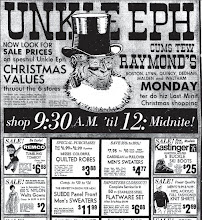


I present more from Mrs. Marjorie H. Gillette's 1967 church history presentation.
I also include a few photos from the Ashburton Place years and some sermon notes published in 1873. Sermon notes were published in the newspapers at that time and remain a wonderful way to look back at various issues that the church was dealing with. I have many of these and shall publish more in future updates.
Mount Vernon Church of Boston began to be known as a "thinking" church and used Sunday sermons and guest speakers from all over the world to explore theological and social issues. The church did not shy away from science, politics and other hard hitting topics.
Part Two of FACTS ABOUT MOUNT VERNON CHURCH 1842 - 1967
Dr. Kirk received his BA degree from Princeton University in three years. The college gave him his Master's Degree in 1825. He studied law for 18 months and decided to attend Princeton Theological Seminary. Amherst College gave him the honorary degree of D.D. in 1855. He became a promoter of revivals, and a lecturer in behalf of missions, temperance, and the anti-slavery movement. Dr. Kirk was considered one of the outstanding preachers of the city and his church became an aggressive agency of evangelism and reform.
Our second minister, Dr. Samuel Edward Herrick was called as an associate minister in 1871 and assisted Dr. Kirk until his death in 1874. His accomplishments were many. He established The American Church in Paris in 1856. Its doors are still open to the European traveller. In 1865 he was elected to become the President of the American Missionary Association. He also served as President of The Board of Trustees of Mount Holyoke College, then a female seminary. In 1870, he was elected to the Board of Trustees of Wellesley College, which office
he held until his death.
The Reverend Samuel E. Herrick was born in Southampton, Long Island, New York, and the son of Captain Austin Herrick, who was the master of a whaling ship. His mother was Mary W. Jagger. Dr. Herrick was graduated from Amherst College at the age of eighteen in 1859. Four years later, he graduated from Princeton Theological Seminary. In 1878, he received an honorary degree of D.D. from Amherst.
Dr. Herrick served as minister of Mount Vernon Church from 1871 to 1904. He was a man of vision, wisdom and a respect for the compatibility of science and religion. He led the church from the old Calvinistic belief towards the new belief based on scientific discoveries. His people were not bound by old dogmas, and their spiritual experience was strengthened by his intellectual approach to religious controversy. He wanted his church to stand for religion and not primarily creed. He was regarded by collectors in New York and London as one of the world's best experts in antiquarian lore. Sophia Woodhull Foster, his wife, a beautiful and gifted woman was the support and inspiration of his whole life.
Part three will follow soon!






